
Detail of Edward Crisp, A Compleat Description of the Province of CAROLINA in 3 Parts. 1st The Improved part from the Survey’s of Maurice Mathews & Mr. John Love. 2ly. the West part by Capt. Thos. Narin. 3ly A Chart of the Coast from Virginia to Cape Florieda. Colored engraving. 32 3/4" x 40". (Courtesy, South Caroliniana Library, University of South Carolina, Columbia, South Carolina; photo, Museum of Early Southern Decorative Arts.) This map was engraved by John Harris in London and published by Crisp about 1711.

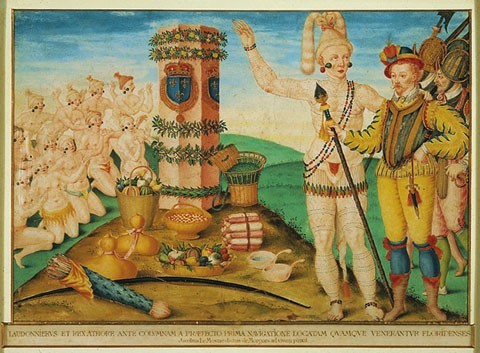
Jacques Le Moyne de Morgue, Réné de Laudonniére and the Indian Chief Athore Visit Ribaut’s Column, probably Paris or London, 1564. 4" x 10". Gouache and metallic pigments on vellum. (Courtesy: Print Collection, Miriam and Ira D. Wallach division of Art, Prints and Photographs, The New York Public Library, Astor, Lenox and Tilden Foundations). Le Moyne was a member of the French expedition that settled at Fort Caroline on the St. John’s River in 1564. Although the colony failed in less than a year, Le Moyne survived and returned to Paris. In 1572, he escaped the Massacre of St. Bartholomew’s Day and fled to London. Encouraged by Sir Walter Raleigh, Le Moyne began drawing and painting plants, insects, and scenes of Indian life remembered from his voyage. His watercolor of commander Réné de Laudonniére and Chief Athore visiting the column erected by the first French expedition is an idyllic depiction of Europeans and Native Americans sharing the riches of the New World. This imagery must have held special meaning for Le Moyne and other Huguenots, who undoubtedly saw America as a place of opportunity and sanctuary (Jessie Poesch, The Arts of the Old South: Paintings, Sculpture, Architecture & the Products of Craftsmen, 1560–1860 [New York: Harrison House, 1983], pp. 3
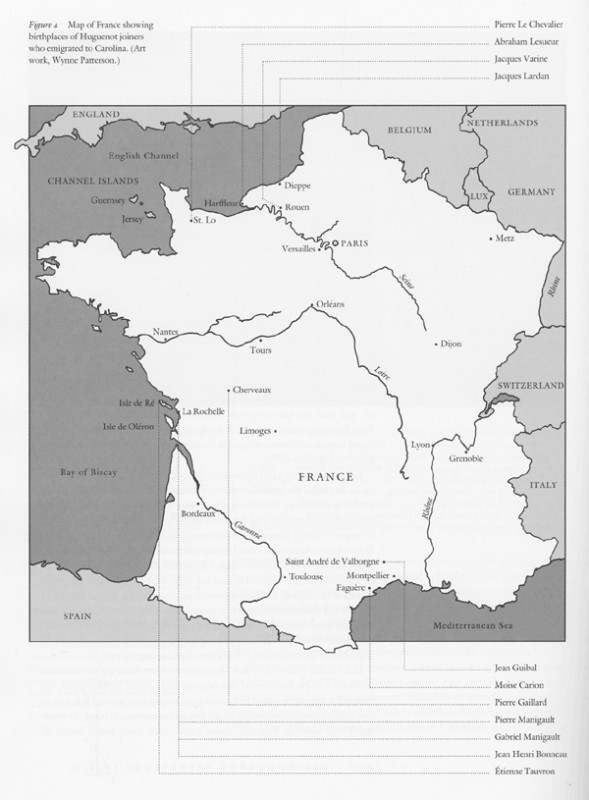
Map of France showing birthplaces of Huguenot joiners who emigrated to Carolina. (Art work, Wynne Patterson.)
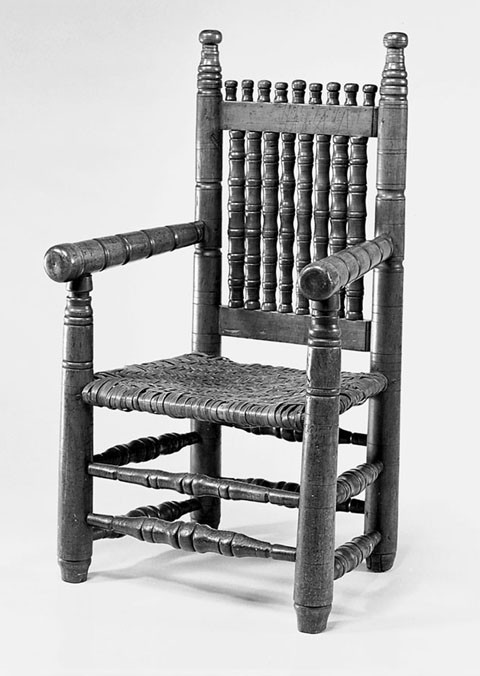
Armchair, coastal South Carolina, 1680–1700. Cherry with ash. H. 41 1/4", W. 23", D. 16 1/4". (Private collection; courtesy, Museum of Early Southern Decorative Arts.)
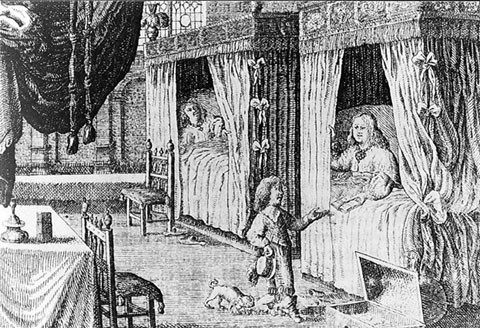
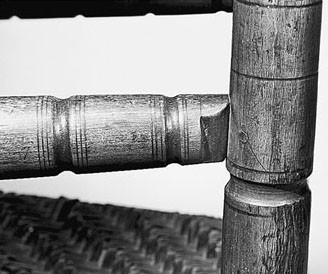
Detail of one of the pinned joints on the armchair illustrated in fig. 5.
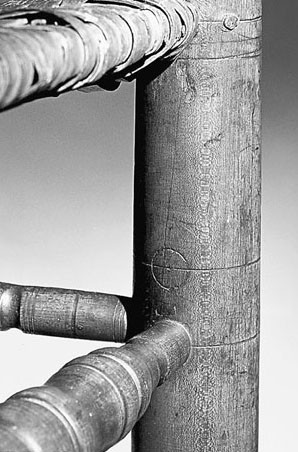
Detail of a partially cut mortise on the armchair illustrated in fig. 5. Another mortise about 1/8" deep also shows evidence of having been drilled with a center bit.

Couch, coastal South Carolina, 1700–1725. Walnut. H. 38 7/8", W. 27 1/4" (seat), L. 80 3/4". The upper portion of the crest rail is missing. (Collection of the Museum of Early Southern Decorative Arts.)
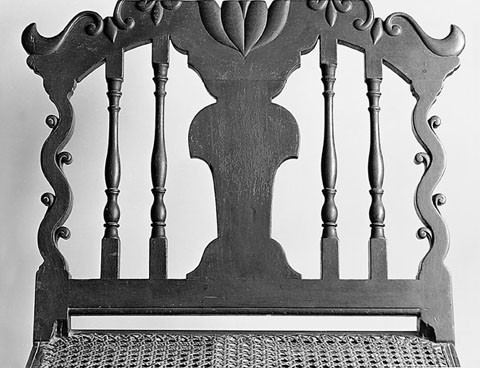
Detail of the back of the couch illustrated in fig. 9.

Gateleg table, probably New York City, 1700–1725. Mahogany with maple and tulip poplar. H. 30 1/8"; top: 58" x 72 1/4" (open). (Courtesy, Historic Hudson Valley, Tarrytown, New York; photo, Gavin Ashworth.) The original owners may have been Philip Van Cortlandt (1683–1748) and his wife, Catherine De Peyster (1688–ca. 1766), who were married in 1710.
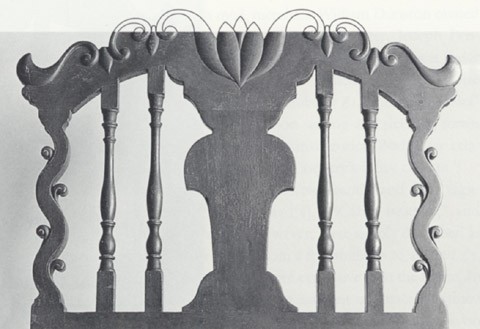
Conjectural drawing of the back of the couch illustrated in fig. 9, showing how the missing carved components on the crest rail probably appeared. (Drawing by Luke Beckerdite, artwork by Wynne Patterson.)
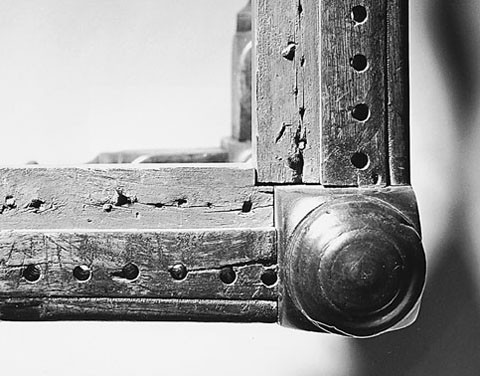
Detail of the nailing evidence for a sacking bottom on the rails of the couch illustrated in fig. 9. The holes adjacent to the beaded edges are from a later cane bottom.
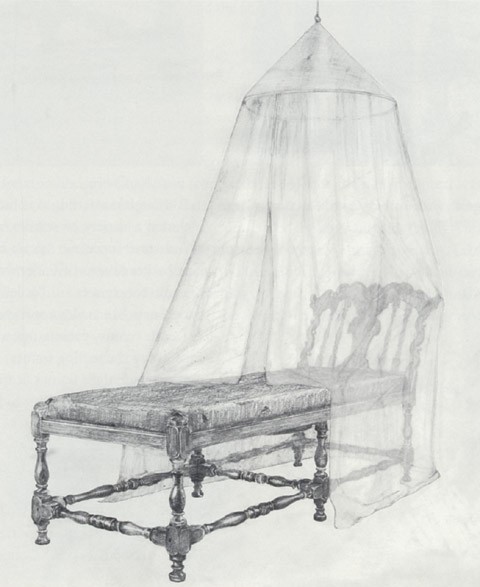
Conjectural drawing of a pavilion based on diagrams in Peter Thornton, Seventeenth-Century Interior Decoration in England, France and Holland (New Haven, Conn.: Yale University Press, 1978), p. 158. (Artwork by Wynne Patterson.)
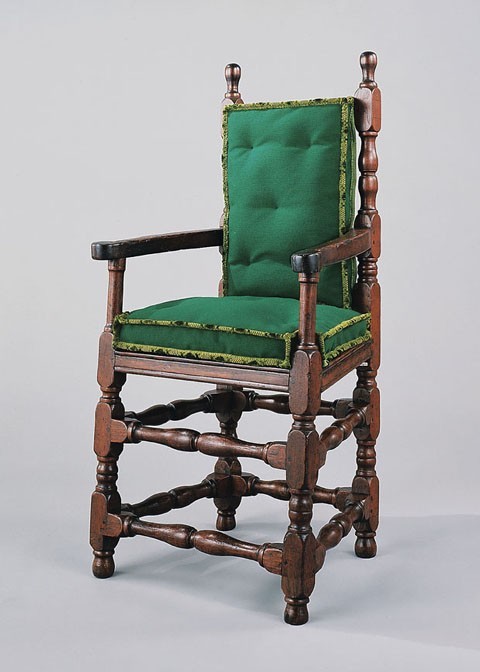
Armchair, possibly coastal South Carolina, 1690–1720. Walnut. H. 45 1/2" (feet restored), W. 22", D. 16 3/4". This chair originally had a plank seat. During the nineteenth or early twentieth century, the seat boards were removed and the upper edges of the beaded seat rails were rounded to accommodate a woven seat. (Courtesy, Colonial Williamsburg Foundation.)
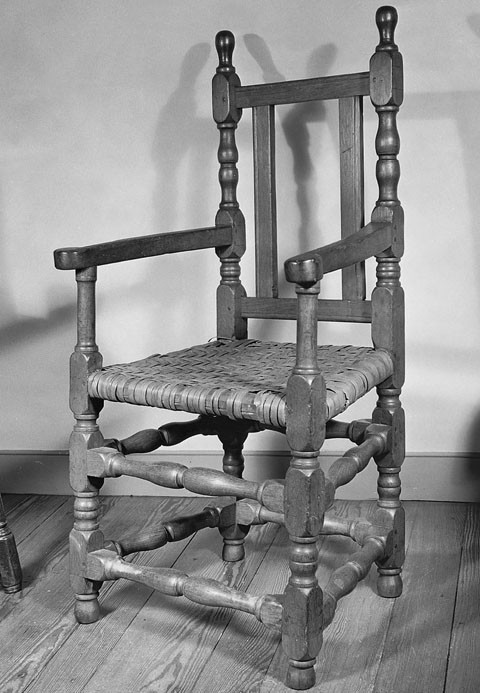
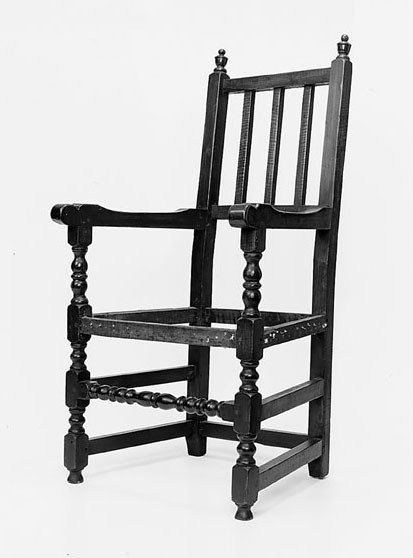
Armchair, probably New York City, 1685–1700. Maple stained red. H. 44", W. 22 1/2", D. 17 1/4". (Private collection; photo Christopher Zaleski.)
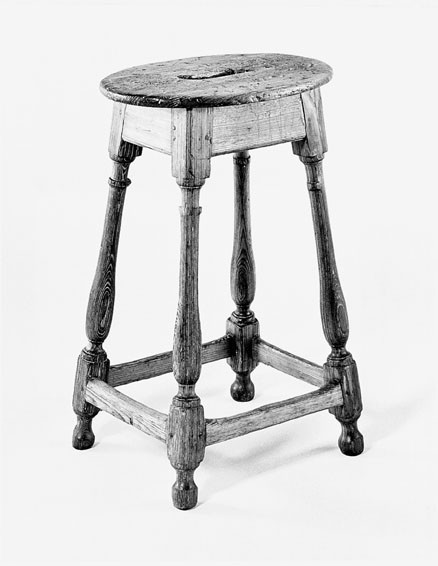
Escabeau, Charleston, South Carolina, 1695–1725. Cypress. H. 24 3/4", W. 15 1/4", D. 113/4". (Collection of the Museum of Early Southern Decorative Arts.)
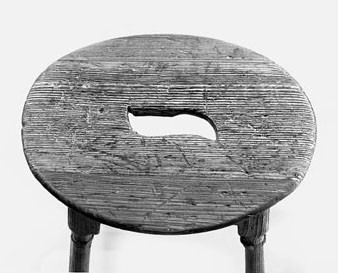
Detail of the top of the escabeau illustrated in fig. 18.

Escabeau, Quebec, 1690–1700. Birch, maple, and pine. H. 22 5/8". (Courtesy, Historic Deerfield.)

Gateleg table, Charleston, South Carolina, 1690–1710. H. 29 1/2"; top: 52 1/4" x 67 1/8" (open). Cypress and red cedar. (Courtesy, The Charleston Museum, Charleston, South Carolina; photo, Gavin Ashworth.) charlestonmuseum.org
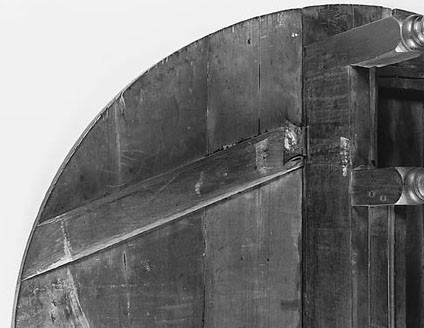
Detail of a batten on the gateleg table illustrated in fig. 21. (Courtesy, The Charleston Museum, Charleston, South Carolina; photo, Gavin Ashworth.) charlestonmuseum.org

Detail of the end of a batten on the gateleg table illustrated in fig. 21. (Courtesy, The Charleston Museum, Charleston, South Carolina; photo, Gavin Ashworth.) charlestonmuseum.org

Gateleg table, northern Europe, 1680–1720. Red pine. H. 28 1/2"; top: 38" x 67 1/4" (open). (Courtesy, Charleston Museum; photo, Gavin Ashworth.) Damage to the rail below the replaced drawer suggests that the original was missing for some time; however, the current cypress drawer appears to be an early eighteenth-century Carolina replacement. The battens under the leaves are chamfered and dovetailed in the same manner as those illustrated in figs. 22 and 23. The turnings of this table are very similar to those on late seventeenth-century chairs from southwestern France. (Courtesy, The Charleston Museum, Charleston, South Carolina; photo, Gavin Ashworth.) charlestonmuseum.org


Henrietta Johnston, Thomas Broughton, Charleston, South Carolina, 1710–1711. Crayon on paper. 10 5/8" x 7 3/4". (Private collection; photo, Museum of Early Southern Decorative Arts.)

Detail of a leg, ogee-molded top, and a dovetailed cleat on the table illustrated in fig. 25.
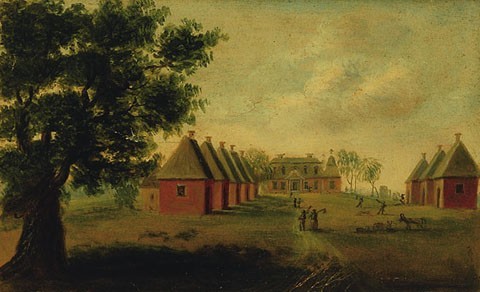
Thomas Coram, View of Mulberry, House and Street, painted in Charleston or Berkeley County, South Carolina, 1805. Oil on paper. 4 1/16" x 61 1/16". (Courtesy, Gibbes Museum of Art/Carolina Art Association, 68.18.01; photo, Museum of Early Southern Decorative Arts.)
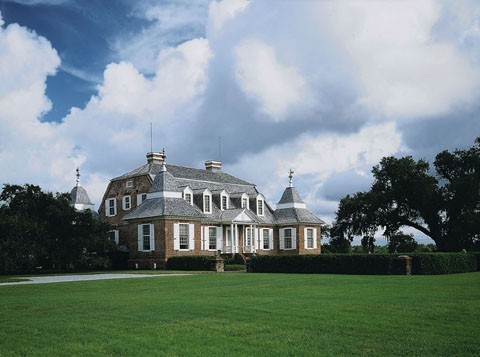
Mulberry, Berkeley County, South Carolina, ca. 1714. (Photo, Gavin Ashworth.)

Detail of a second-floor room in Mulberry. (Photo, Gavin Ashworth.)
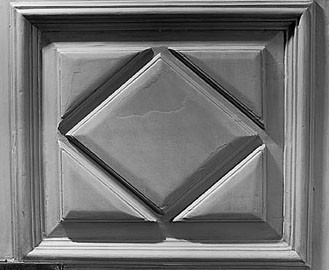
Detail of the central panel of the door illustrated in fig. 30. (Photo, Gavin Ashworth.)
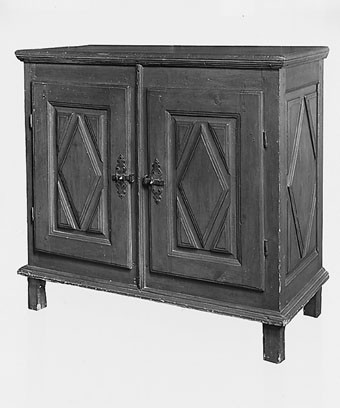
Buffet bas, Quebec, ca. 1700. Red pine painted red. H. 39 3/4", W. 41 5/8", D. 19". (Courtesy, Historic Deerfield.)
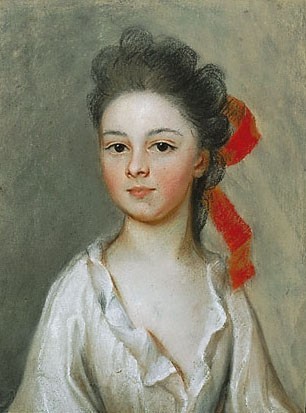
Henrietta Dering Johnston, Henriette Charlotte de Chastaigner, 1700-1754. Pastel on paper. 11 5/8" x 8 7/8". (Courtesy, Gibbes Museum of Art/Carolina Art Association, 38.20.04; photo, Museum of Early Southern Decorative Arts.)

Limrick, Berkeley County, South Carolina, ca. 1711. (Courtesy, Library of Congress.)
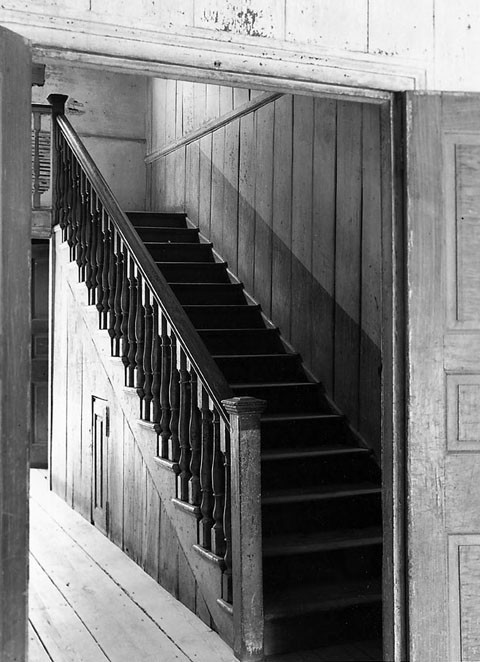
Detail of the stair in Limrick. (Courtesy, Library of Congress.)
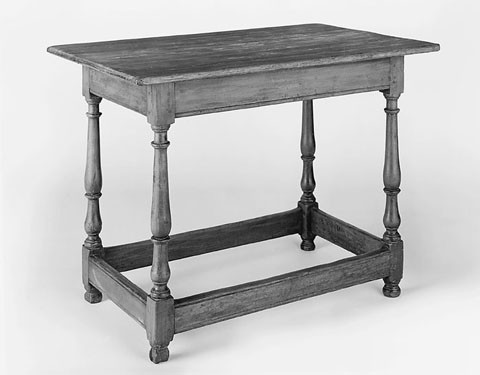
Table, probably Berkeley County, South Carolina, ca. 1711. Cypress with traces of original red paint. H. 27 7/8", W. 36 3/16", D. 23 1/4". (Courtesy, The Charleston Museum, Charleston, South Carolina; photo, Gavin Ashworth.) charlestonmuseum.org

Table, coastal South Carolina, 1780–1820. Cypress painted blue. H. 28 1/4", W. 37 1/2", D. 22 1/2". Courtesy, The Charleston Museum, Charleston, South Carolina; photo, Gavin Ashworth.) charlestonmuseum.org
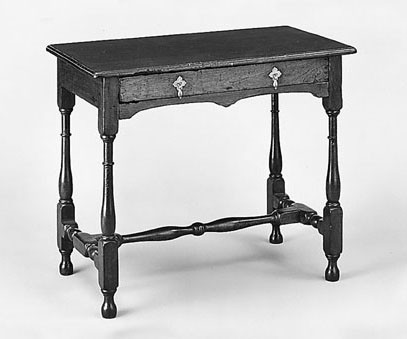
Dressing table, probably Charleston, South Carolina, 1700–1720. Mahogany with red bay. H. 28", W. 32 3/4", D. 18 1/2". (Courtesy, Colonial Williamsburg Foundation.)

Table, probably Charleston, South Carolina, 1700–1720. Cypress painted black. H. 27 5/8", W. 26", D. 21". (Collection of the Museum of Early Southern Decorative Arts.)
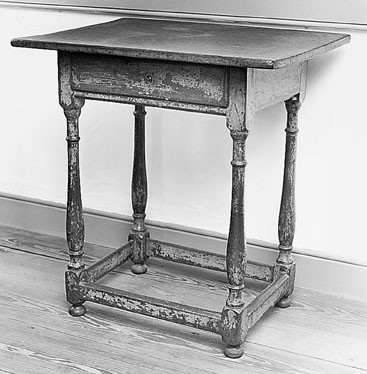
Table, coastal South Carolina, 1700–1720. Walnut and tulip poplar with yellow pine. H. 29 1/2", W. 27 1/2", D. 21 1/4". (Courtesy, National Park Service, George Washington Birthplace National Monument, GEWA20433; photo, Museum of Early Southern Decorative Arts.)
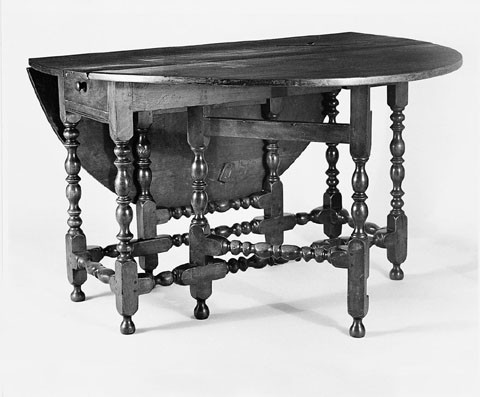
Gateleg table, Charleston, South Carolina, 1700–1725. Walnut with yellow pine and cypress. H. 291/2"; top: 47 3/4" x 57 1/2". (Collection of the Museum of Early Southern Decorative Arts.)

Henrietta Johnston, Samuel Prioleau, Charleston, South Carolina, 1715. Crayon on paper. 12" x 9". (Collection of the Museum of Early Southern Decorative Arts.)
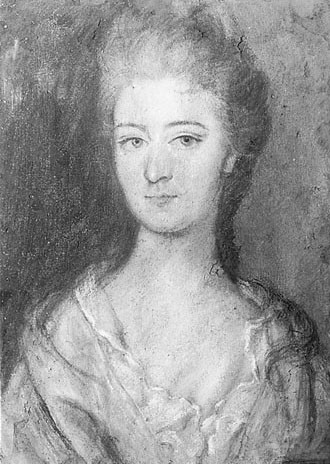
Henrietta Johnston, Susanne Le Noble, Charleston, South Carolina, 1710. Crayon on paper. 10 7/8" x 6 3/4". (Private collection; photo, Museum of Early Southern Decorative Arts.)
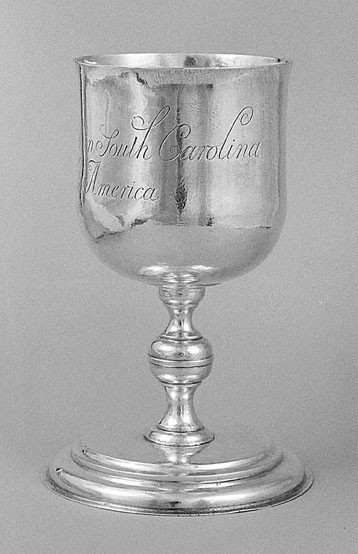
Sacramental plate for Biggin Church, St. John’s Parish, South Carolina, including: (a) Standing cup by Miles Brewton, Charleston, South Carolina, ca. 1711. Silver. H. 7 5/8". Silver gilt. Dimensions unrecorded. (Courtesy, Museum of Early Southern Decorative Arts.)
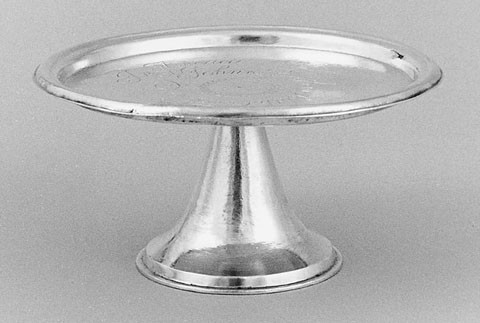
Sacramental plate for Biggin Church, St. John’s Parish, South Carolina, including: (b) Paten by Miles Brewton, ca. 1711. Silver. H. 2 15/16", Diam. 5 3/4". Silver gilt. Dimensions unrecorded. (Courtesy, Museum of Early Southern Decorative Arts.)
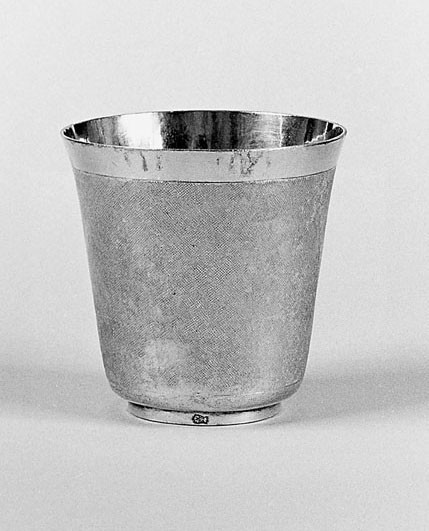
Sacramental plate for Biggin Church, St. John’s Parish, South Carolina, including: (c) Cup, Paris, seventeenth century. Silver gilt. Dimensions unrecorded. (Courtesy, Museum of Early Southern Decorative Arts.)
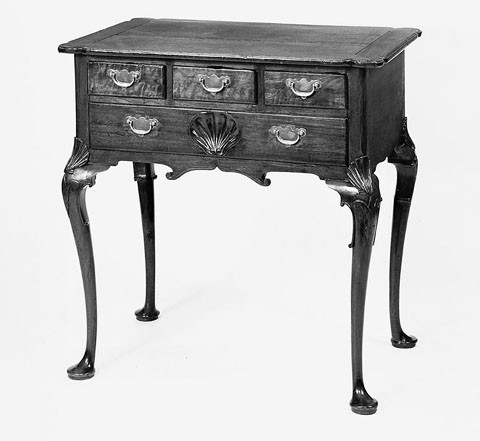
Dressing table, Charleston, South Carolina, 1725–1735. Walnut. H. 31 5/8", W. 3 13/4", D. 21". (Collection of the Museum of Early Southern Decorative Arts.) The dressing table has an illegible inscription written in French.
The place called Charles Town . . . [is] very commodiously scituated from many other Navigable Rivers that lie near it on which the Planters are seated; by the Advantage of Creeks, which have a Communication from one great River to another . . . the Planters may bring their Commodities to the Town . . . for Trade and Shipping. . . . At our being there was judged in the Country a 1000 or 1200 Souls; but the great Numbers of Families from England, Ireland, Berbadoes, Jamacia, and the Caribes, which daily Transport themselves thither, have more than doubled that number.
Carolina
—Thomas Ashe, 1682
In December 1679, Thomas Ashe and forty-five French Protestant refugees sailed for Carolina aboard the royal frigate Richmond. They landed the following April, shortly before the seat of government moved to the “Poynt of Land” dividing the Ashley and Cooper Rivers (fig. 1). Instructed “to enquire into the State of the Country, by his Majesties Special Command,” Ashe meticulously catalogued commodities suitable for export and speculated about products that could be manufactured in Carolina, particularly naval stores, wine, olive oil, and silk.[1]
The Low Country’s semitropical climate and diverse natural resources were foreign to most European emigrés, but no more so than the human landscape. By the time Ashe published Carolina, the region was inhabited by settlers from the British West Indies, England, Ireland, France, and Switzerland; by American Indians; and by African slaves. Soon to follow were immigrants from Scotland, the Netherlands, Portugal, and Germany; colonists from other areas of North America; and vast numbers of slaves whose ethnic backgrounds were as diverse as the white population. The patterns of interaction and cultural exchange that emerged among these diverse people during the first sixty years of settlement were remarkably fluid. Each group maintained a degree of ethnic and cultural identity; yet, at the same time, the challenges of early colonial life bound them together.[2]
This article explores the social and cultural context of Low Country decorative arts from 1680 to 1735. Only a handful of objects from this period are known, but they document the presence of diverse European craft traditions and the adaptation of those traditions to the environment and the demands of a pluralistic society. More importantly, they illuminate the dynamic process of cultural transfer, confrontation, and accommodation that began with the first organized efforts to colonize the region.
Settlement
In 1663, Charles II rewarded eight political allies with a vast proprietary grant that included South Carolina. After two failed attempts to colonize Carolina from Barbados, Lord Ashley persuaded his fellow proprietors to contribute £500 each to purchase passage, equipment, and provisions for two hundred colonists. The first settlers landed about sixty miles northeast of Port Royal in March 1670, but soon moved to a neck of land on the west bank of the Ashley River. By 1672, they had laid out town lots and built a palisade fort and approximately thirty houses. For the following eight years, this village served as the capital and as a commercial center for the farms and plantations along the Ashley and Cooper Rivers.[3]
By colonizing Carolina, the proprietors hoped to profit from the development of large personal estates, from the collection of quit-rents from each landowner, and from the production of commodities not yet raised or manufactured in Britain. To encourage settlement by “men of estate,” they awarded sizable grants to individuals or partners who transported large numbers of indentured servants. Seth Sothell, for example, received twelve thousand acres in 1675 for agreeing to build thirty houses and “seat” 120 colonists. Although several members of the “lesser” gentry came to Carolina, most of the early immigrants were yeomen, tradesmen, and indentured servants—all attracted by the availability of inexpensive land and the commercial opportunities that Carolina offered.[4]
A large percentage of the colonists who arrived during the first decade of settlement were Barbadians. Unlike their English counterparts, many of the Barbadians were from prominent planter families. The introduction of sugar cultivation had caused land prices on the island to rise geometrically between 1640 and 1670. As smaller tracts became consolidated into large estates, displaced Barbadian planters, smaller landowners, and freemen looked to Carolina for new economic opportunities. The wealthiest individuals arrived with slaves and servants, acquired vast tracts of land, and formed a powerful political faction during the first forty years of settlement.[5]
Dutch, Swiss, and French colonists also settled in the Low Country during the late seventeenth century. A Compleat Description of the Province of CAROLINA, published by Edward Crisp about 1711, shows two Dutch residences near Charleston on the Ashley River (fig. 2). The Dutch represented only a small fraction of the population and were primarily merchant-traders and yeomen. Only a few tradesmen, such as joiner John Vanderhorst (d. 1715), are identified in seventeenth-century records. He arrived with a small group of Dutch immigrants in 1694.[6]
The Huguenots who emigrated to South Carolina during the 1680s and 1690s were far more numerous and diverse. Approximately 56 percent were from western coastal provinces of France, 31 percent were from inland provinces or from southeastern France, and 13 percent were born outside France. Most of the Huguenots from the western provinces sought refuge initially in England or the Netherlands. Merchant Isaac Mazicq fled from Isle de Ré to Amsterdam with £1500 sterling. From there he traveled to London, where he purchased interest in a cargo and passage on a ship bound for Charleston. In 1685, he wrote, “God gave me the blessing of . . . escaping the cruel persecution . . . and . . . I promise . . . to observe the anniversary . . . with a fast.” Protestants from the southeastern provinces typically fled to Switzerland or Germany. Silversmith Solomon L’Egaré was away at college when he received word that his parents had escaped from their home at Lyons in Champagne and that he was to disguise himself as a peasant and flee to Geneva. Solomon subsequently joined his family in Bristol, England, where they resided for several years before emigrating to America. His father, François, and two of his brothers went to Massachusetts in 1691, and Solomon went to Charleston.[7]
Huguenots such as Mazicq and L’Egaré probably had knowledge of Carolina before the diaspora. French perceptions of the New World were shaped by late sixteenth-century publications such as Jacques Le Moyne de Morgue’s illustrated account of the French expedition to Florida and South Carolina (fig. 3), by promotional tracts such as Ashe’s Carolina and Charles de Rochefort’s Histoire naturelle et morale des Iles Antilles (1652), and by the personal experiences of “old” diaspora Huguenots, conveyed through friends and family members living in sympathetic Protestant countries. In 1685, Judith Giton wrote:
For eight months we had suffered from the. . . . soldiers. . . . We therefore resolved on quitting France at night . . . and abandoning the house with its furniture. We went to Romans . . . and there contrived to hide ourselves for ten days, whilst a search was made . . . we passed on to . . . Cologne, where we left the Rhine and took Wagons to Wesel. . . . [A] host who spoke a little French . . . told us that we were only thirty leagues from Lunenburg. We knew that you [her brother] were there. Our deceased mother and I entreated my eldest brother to . . . go that way; or else . . . to go himself to see you. . . . But he would not hear of it, having nothing on his mind but ‘Carolina’. . . . After this, we passed into Holland, in order to go to England. We were detained in London for three months, waiting for a vessel to set sail for Carolina.
Although Giton’s sojurn in London was brief, nearly half of the Huguenots who emigrated to South Carolina had lived in England more than five years. The growing population of Protestant refugees and the attendant decline in jobs undoubtedly influenced their migration to the colonies. Unlike Quakers, Presbyterians, AnaBaptists, and other “dissenters,” the Crown placed few religious or civil restrictions on the Huguenots. This tolerance suggests that economic opportunity was the primary motive for emigration.[8]
The first contingent of Huguenots arrived in 1680 on the Richmond. Organized by René Petit and Jacob Guérard, this group included a high percentage of families and tradesmen “skilled in ye manufacture of silkes, oyles, and wines.” To minimize conflicts with their English-speaking neighbors, most of the Huguenots settled north of Charleston on a tributary of the Cooper River, later known as French Quarter Creek. Immigration increased following Louis XIV’s revocation of the Edict of Nantes in 1685, and by 1700 over 325 refugees had arrived in Charleston. During the seventeenth and early eighteenth centuries, the principal Huguenot-settled areas were along the south bank of the Santee River, on Goose Creek, on the eastern and western branches of the Cooper River, and in Charleston (see French names and “French Settlement” designated in fig. 1). This pattern probably resulted from the availability of land, since the Huguenots never attempted to isolate themselves from the British population.[9]
Huguenot Artisans and Artisanry
Of the twenty-one joiners and carpenters known to have worked in the Charleston area before 1700, ten were British, nine were Huguenots, and two were of undetermined descent. In many respects, the diaspora of the Huguenot joiners is representative of the Carolina refugees as a whole (fig. 4). Jacques Varine, Pierre Le Chevalier, Jacques Lardan, and Abraham Lesueur were from Normandy. Varine (fl. 1680–1688/89) and his family were among the French Protestants who arrived on the Richmond in 1680. Born in Rouen, he resided in London for at least six years before emigrating to South Carolina. Pierre Le Chevalier (fl. 1692–1712) came from Saint Lo, about 150 miles west of Rouen. Although his arrival date is not known, he purchased a lot in Charleston on October 19, 1692, and his residence is shown on Edward Crisp’s map (see fig. 2). Jacques Lardan was born in the port of Dieppe, a major point of departure during the Huguenot diaspora. He acquired a lot in Charleston in 1694, applied for naturalization in 1696/97, and died the following year. Abraham Lesueur (fl. 1696–1740) came from Harfleur, near the mouth of the Seine. He also appears on the 1696/97 list of French and Swiss refugees in Carolina, and he had an unusually long career in Charleston.[10]
Pierre (1664–1729) and Gabriel (ca. 1666–ca. 1702) Manigault were born in La Rochelle, the great Protestant fortress on the coast of Aunis. They probably arrived in Charleston about 1695. In June of that year Gabriel received a warrant for one hundred acres for the arrival of himself and a “negro” named Sambo. Pierre married Judith Giton in 1699, and he fathered two children—Gabriel (1704–1781) and Judith. Pierre Galliard (fl. 1693/94–1710) was from the village Cherveaux, about fifty miles northeast of La Rochelle in Poitou. He and his wife, Magdelane, came to South Carolina in 1693/94 and subsequently purchased land in Jamestown, a French and Swiss settlement on the south bank of the Santee River. Étienne Tauvron was born on Isle de Ré, off the coast of La Rochelle, and arrived in Charleston by 1696/97. He helped inventory the estate of Jacques Lardan in 1698, and he witnessed the will of Pierre Le Chevalier in 1702.[11]
Jean Guibal (1696–1703) and Moise Carion were from the southeastern province, Languedoc. Guibal was born in Saint André de Valborgne. He received a warrant for land in Carolina in January 1695/96 and was one of five individuals commissioned to sell lots in Jamestown. Carion (fl. 1696–1697) was born in Faguère, about forty miles from Saint André de Valborgne. He, his wife, Ann (Riboteau), and son, Moise, were among several Santee-area Huguenots who petitioned for naturalization in 1696/97. Carion purchased three adjoining lots in Jamestown in 1705/6, but the town failed owing to frequent flooding of the Santee.[12]
A massive great chair with a South Carolina recovery history probably represents the work of a first-generation Huguenot joiner (fig. 5). The spindle-and-rail construction of the back is repeated on vernacular French chairs depicted in mid-seventeenth-century paintings by the Le Nain brothers and on French-style chairs (fig. 6) illustrated in Søren Terkelsen’s Dend hydrinade Astrea (1645). The latter also have small spindles pinned to their upper rails like those of the great chair. Unlike turned armchairs from the northern and middle colonies, which typically have arms tenoned into the front posts, the great chair has large turned arms that extend beyond the front posts. Chairs with overpassing arms from Normandy and Brittany are illustrated in early volumes of Vie à La Campagne, but similar examples were probably made throughout the provinces as well as in other areas of northern Europe. Related arms also occur on chairs from southeastern Virginia and eastern North Carolina, the earliest of which have spindle-and-rail backs, turned feet, or other details associated with Continental furnituremaking traditions.[13]
With the exception of the long back spindles and upper stretchers, every joint on the great chair is pinned (figs. 7, 8). The pins securing these joints are set at acute angles, and their use may stem from the earlier practice of pinning rectangular and round through-tenons. The holes for the tenons were drilled with a center bit (fig. 8) rather than a pod auger, or spoon bit, which was used by most chairmakers during the late seventeenth century. The presence of this tool and the fact that the chair was turned on a great wheel lathe suggest that it is an urban product, despite its nonarchitectural turnings. The seat is lower than normal and may have been fitted with a thick cushion.[14]
In early South Carolina inventories, turned chairs are generally described by their paint color or by their seat material, whereas joined chairs are more often identified by their wood. In 1692, merchant William Dunston owned ten “palmato chaires” valued at £1.6.15. Three years later, Joseph Penderves’s inventory listed “2 permeto chaires” valued at 2s 6d, “1 Great Sedar Elbo Chaire” valued at 5s, “1 Small Sedar Ditto” valued at 1s 6d, “1 Chaire Cushion” valued at 1s, and two hammocks valued at £1. “Palmetto chairs” and hammocks are among the most common seating and sleeping forms listed in seventeenth-century South Carolina inventories. Both were relatively inexpensive and well suited to the Low Country’s sultry climate.[15]
No early Carolina bedsteads survive, but seventeenth- and early eighteenth-century forms included “Cott Bead[s],” “Cabin bead[s],” and “Standing Bed Stids.” Most bedsteads, however, were simply described as “new” or “old,” with appraisals ranging from a few shillings to around £3. Almost invariably, the bed furniture was more expensive than the frame. In 1686, merchant Paul Grimball submitted an account of losses sustained when a Spanish raiding party from St. Augustine ransacked his house on Edisto Island. His inventory included “1 hammock 1.0.0 . . . 5 beedsteads broke & spoyld 0.15.0 . . . 7 beeds bolsters & pillows 30.0.0 . . . 2 large wosted Ruggs & Cadoes 3.0.0 . . . 14 blankets for beeds 12.0.0 . . . 4 cors Ruges 3.0.0 . . . 30 pr. sheets 30.0.0 . . . 20 pillobears 5.0.0 . . . 1 sheet of Reed serge curtains & valians last & fringed wth silk 10.0.0 . . . [and] 3 sheets of Bed curtains more 12.0.0.” The curtains appear to have been for his personal bedstead, whereas the remaining items were stock.[16]
Couches, or “day-beds,” were used in place of bedsteads and hammocks in some households. John Boyden’s inventory listed one “couch bedstead . . . £2.10” in 1726, and William Ramsey’s listed “3 old beds, couch beds, pillows & bolsters . . . £35” in 1733. The couch illustrated in figure 9 is the only surviving example from the Low Country. It is considerably larger than most colonial couches, and it has a fixed back rather than an adjustable one. The spindles flanking the splat (fig. 10) resemble the legs on a gateleg table that descended in the Van Cortlandt family of New York (fig. 11). Both sets of turnings have superimposed balusters with distinctive cup-shaped elements. Similar turnings also occur on a contemporary New York draw bar table that almost certainly represents the work of a northern European immigrant. A French or Germanic origin for the maker of the couch is suggested by its serpentine stiles—intended to represent twisted columns—and fleur-de-lis carving (figs. 10, 12). Although few Germanic people emigrated to the Low Country before 1730, Teutonic styles may have arrived earlier with Huguenots who had sojourned in one of the Protestant states or in countries influenced by them. Regional settlement patterns and material culture both suggest that the Huguenots introduced a variety of north European details, not all of which were purely French.[17]
The caned seat on the couch replaces its original “sacking,” which was tacked into the rabbets on the inner edges of the rails (fig. 13). Sacking typically consisted of a canvas edge with sewn grommets and rope lacing; however, some systems had a central canvas panel suspended by the roping. Ornate couches like this example frequently had a costly suite of cushions, often including a squab, bolster, and pillows. Some may have been fitted with “pavilions,” or canopies, like the one that accompanied Daniel Gale’s hammock in 1725. Low Country inventories and correspondence indicate that most pavilions were simple, utilitarian devices made of netting or other thin, inexpensive fabrics (fig. 14) rather than the costly textiles used on their court counterparts. In 1725, Margaret Kennet wrote, “we have . . . a very troublesome . . . Insect which are called the muschatoe . . . so that all the Hott months we are forced to use pavilions made of Catgut Gause. Twenty yds. maks a Pavilion.” During the seventeenth century, “pavilion” was the French term for a cone- or dome-shaped fixture suspended from the ceiling by a cord, “with a valence . . . and with two or three large curtains that . . . had to drag on the ground . . . to be long enough to . . . encompass the foot end.” Textile historian Audrey Michie has suggested that Huguenots may have introduced the term “pavilion” in the Carolinas.[18]
Although no netting was listed among Paul Grimball’s losses, his stock included a variety of textiles, materials, and tools for the production of upholstered furniture: “12 1/2 hids of english tand sole leather . . . 12 Rich new backes & seats of Turky work: for chear . . . 3: doz of reed lether backes & seates for cheares . . . Tooles for Carpendors Joyners Turnors . . . [and] a parsell new bras nailes 2 sorts for cheares.” As these references suggest, seventeenth-century patrons often purchased upholstery materials before commissioning the seating frames. Rather than altering the textile, most chairmakers made their frames fit the upholstery. This practice was particularly common for turkeywork, which was woven into panels and had a selvage suitable for nailing. The “backs & seats” in Grimball’s inventory were probably for low-backed stools—commonly referred to as “farthingale” or “Cromwellian” chairs—or for their more fashionable high-backed counterparts, occasionally referred to in English inventories as “French chairs.” Parisian upholsterers began making gands fauteuils, or “grand chairs,” with high, raked backs during the early 1670s, and variations of the form remained popular on the Continent and in Britain through the seventeenth century.[19]
The turned and joined armchair illustrated in figure 15 may be a rural South Carolina interpretation of the grand chair. It first surfaced in the “Questions and Answers” section of Antiques in August 1926. Judging from the editor’s response, the owner asked if the chair could be “associated with the early coming of Huguenot settlers to the South.” Five years later, furniture historian Paul Burroughs attributed the chair to South Carolina in Southern Antiques. Most of his attributions were based on family or recovery histories.[20]
The maker of the Carolina chair angled the arm, seat rail, and stretcher joints to create a backward list rather than by sawing the rear posts out of wide boards or by using double-axis turning. The stretchers join the posts at the same level on all four sides, and the seat rails have half-inch-wide beads and rabbeted edges that originally supported a plank seat. The open back frame provides little support for the sitter (fig. 16), which suggests that the chair had a tied-on squab, or carreau, and a matching one for the plank seat. Furniture historian Peter Thornton has noted that French upholsterers “fitted both seat and back with squabs, which were tied on with ribbons . . . [but] there appears to be no English parallel for this French practice before the . . . early nineteenth century.” A similar complement of cushions evidently accompanied a contemporary New York armchair (fig. 17). Next to South Carolina, New York had the largest Huguenot population in colonial America.[21]
Low Country appraisers typically used prevailing English terms for furniture. French forms, such as gands fauteuils, coffres, armoires, and escabeaux, were probably referred to as elbow chairs or great chairs, chests, presses or cupboards, and stools. Escabeaux were simple stools used in houses and in churches where they may have functioned as coffin, or “bier,” stands. The cypress example illustrated in figure 18 has a history of use in the Miles Brewton house in Charleston (completed 1769), but its original context was much earlier. Although it is thought to have come from an earlier dwelling in the Brewton family, it may have descended in the Manigault family who occupied the house from the late nineteenth century until the present. Like many French escabeaux, it has splayed legs and a top with a shaped cut-out (fig. 19). Its elongated baluster turnings suggest a date of 1700–1720, making it roughly contemporary with the French-Canadian example illustrated in figure 20.[22]
The only cultural designation for furniture in early Carolina inventories is “Dutch”—a term that had both specific and generic meanings depending on its usage. “Dutch chairs” and “Dutch tables,” for example, probably referred to objects perceived as having Continental details rather than being literally Dutch in origin or form. The “old Round Dutch flap table” listed in the 1726/27 inventory of Alice Hogg’s estate may have resembled a late seventeenth- or early eighteenth-century falling-leaf (or gateleg) table that descended in the Manigault family (fig. 21). Attached to the end rail is a nineteenth-century plaque engraved “Gabriel Manigault/1739.” This inscription and the Manigault family genealogy suggest that the table belonged to the immigrant Gabriel or that it descended from his brother Pierre to his nephew Gabriel. Both Pierre and his brother were joiners, and either could have constructed this table if they had learned turning or if they purchased the turned components from a specialist. Alternatively, they could have purchased the table from a local turner or joiner.[23]
The Manigault table has an oval top with butt-joints between the leaves and center section, random-width boards, long tongue-and-groove joints, and wide dovetailed battens that prevent the top from warping (figs. 22, 23). This distinctive batten system also occurs on a northern European gateleg table with an early eighteenth-century cypress drawer (fig. 24). The remaining structural and stylistic details on the Manigault table are somewhat more generic. The top and drawer runners are attached with nails rather than pins, and wear marks on the legs indicate that the missing drawer had a front that extended below the drawer bottom. The lower edge of the drawer may have been shaped, and it almost certainly had an ogee molding like the end rail.[24]
The primary woods of the Manigault table—red cedar and cypress—are the most common ones specified in early inventories. Ashe wrote that Carolina was “cloathed with odoriferous and fragrant . . . Cedar and Cyprus Trees, of . . . which are composed goodly Boxes, Chests, Tables, Scrittores, and Cabinets. . . . Carolina [cedar] is esteemed equal . . . for Grain, Smell and Colour . . . [to] Bermudian Cedar, which of all the West Indian is . . . the most excellent.” During the seventeenth and early eighteenth centuries, regional merchants and tradesmen maintained large stocks of these and other woods. In 1694, merchant John Vansusteren’s inventory listed “900 foot of Ceader bords . . . [and] 80 foot of Ceader Plank,” and joiner James Beamer’s listed two hundred feet of cedar boards and a large “parcel of Cedar.” Twelve years later, joiner Jean du Brevill sold two thousand feet of cypress boards to merchant Francis LeBrasseur.[25]
Contemporary promotional tracts and surviving furniture also document the presence of trees not commonly associated with the Low Country. A Brief Description of the Province of Carolina (1666) stated that “Walnut-trees of great growth” and cherry thrived in “the barren sandy ground.” Although the preceding armchairs and a small group of tables support that claim, the easternmost supplies of black walnut and cherry may have been exhausted by the middle of the eighteenth century.[26]
The walnut stretcher table illustrated in figure 25 reportedly belonged to Colonel Thomas Broughton (fig. 26) of Mulberry Plantation (see “Mulbery” on the Cooper River at the top of fig. 1). Its ogee rail moldings, baroque, baluster-shaped turnings, and compressed, ball-shaped feet resemble those of the Manigault table, though the Broughton example may be at least a decade later. The top of Broughton’s table also has an ogee molding identical to those on the rails and stretchers below, and it has one-inch-thick, dovetailed cleats that were originally secured to the frame with three pegs each (fig. 27). Tables with dovetailed cleats were produced throughout northern Europe from the Renaissance to the nineteenth century.[27]
Broughton (d. 1737) emigrated from the Leeward Islands before January 20, 1696. He held several ranks in the South Carolina militia, served intermittently as an assemblyman for Berkeley and Craven Counties, and amassed a sizable fortune in the Indian trade. In 1706, he purchased land on the northwestern branch of the Cooper River in Berkeley County and became a planter. Five years later, Anglican minister Francis LeJau wrote, “I now have no leading man or men of authority in my Parish, Col. Broughton had left us 3 months ago to go and live upon his fine seat fourteen miles off.”[28]
Broughton’s “fine seat” is depicted in a late eighteenth-century watercolor by Charleston artist Thomas Coram (fl. 1769–1780) (fig. 28). In the foreground are rows of slave houses with high, steep roofs, small windows, and arched doors. These dwellings appear to be somewhat later than Broughton’s house, Mulberry, which probably dates to 1711–1714. Partially shown in the background, Mulberry is a one-and-a-half-story, English bond, brick building with a jerkin-head gambrel roof and four adjoining, single-story pavilions. The house originally had a gable roof, but it was altered to the present form before Coram’s painting (fig. 29). Architectural historian Thomas Waterman argued that Mulberry’s design derived from sixteenth-century French chateaux and pointed out similarities between Mulberry and vernacular houses in French-settled areas of Virginia and the West Indies. Other scholars have suggested that late seventeenth-century Netherlandish and French tower houses may have provided the inspiration for Mulberry’s distinctive pavilions.[29]
The interior was extensively remodeled during the nineteenth century, but remnants of original woodwork on the second floor document the involvement of European-trained joiners (fig. 30). The doors have central panels with molded, lozenge-shaped designs, or pointes des diamant, and complex applied moldings around the panel fields (fig. 31)—details that occur frequently on late seventeenth- and eighteenth-century French furniture (fig. 32) and architectural woodwork. The presence of such details should come as no surprise given Berkeley County’s large Huguenot population and Broughton’s ties to that community. He was, for example, acquainted with refugee artisans, including joiner Pierre Le Chevalier, and Broughton’s son, Nathaniel, married Henriette Charlotte de Chastaigner (fig. 33), whose father, Alexander, was from Rochelais nobility.[30]
Contemporary Huguenot houses provide an interesting contrast with Mulberry. Daniel Huger’s (1688–1754) house, “Limrick” (fig. 34), was built between the Cooper and Wando Rivers about fifteen miles southeast of Mulberry. His parents, Daniel (1651–1711) and Margaret (Perdriau), were born at Loudun in Poitou. Like many Huguenots from that province, they subsequently moved to La Rochelle, where their daughter Marguerite was born. In 1682 they boarded a ship at Isle de Ré and escaped to England, where they resided for approximately twelve years. The Hugers’ early flight may have enabled them to preserve some of the wealth that Daniel, Sr., had accumulated in his mercantile business. He purchased three lots in Charleston in 1694 and several hundred acres of land in Craven County between 1696 and 1709. Daniel, Jr., inherited a portion of this land in 1711 and subsequently acquired additional acreage in Craven County and Berkeley County.[31]
Limrick was built on Daniel’s Berkeley County plantation about 1713. The house burned in 1945, but photographs reveal that it was a two-story, frame structure with a tall gable roof, enclosed chimneys, and a central hall (fig. 35). The principal rooms of the first floor had fireplace walls with raised paneling and bolection-molded surrounds that resemble the earliest ones in Mulberry. The stair balusters in the hall were probably turned by the same artisan that made a tea table reportedly from Limrick (fig. 36). Both sets of turnings feature an elongated ogee baluster over a compressed smaller one. In the colonies, superimposed balusters occur primarily on furniture from New York and South Carolina (see figs. 10, 11). As the table illustrated in figure 37 demonstrates, this pattern remained fashionable in rural areas of the Low Country well into the nineteenth century.[32]
The most prevalent turning on early Carolina tables is a long slender baluster with a thin collarino just below the capital. A dressing table and two small side tables illustrate three different interpretations of this regional pattern (figs. 38-40). The dressing table is made of mahogany and red bay, a local hardwood that naturalist Mark Catesby described as “fine gran’d, and of excellent use for cabinets, &c.” (fig. 38). Although mahogany first appears in Charleston records in 1730, it was probably being imported by the beginning of the eighteenth century. The feet of the dressing table resemble those of the escabeau (fig. 18), but they have a distinct cavetto below the torus rather than a simple fillet. Torus-and-cavetto moldings also function as capitals for the balusters of the table. The side tables (figs. 39, 40) have compressed, ball-shaped feet that are more closely allied to those of the Manigault, Broughton, and Limrick tables (figs. 21, 25, 36), and their delicate leg turnings, crisp, ogee-molded rails and stretchers, and finely cut dovetails mark them as urban products. Tables similar to these were undoubtedly made by artisans of both British and Continental descent.[33]
Although northern European and English styles were dominant in the Low Country, a Charleston gateleg table with an oral tradition of ownership by Henry Laurens (1724–1792) probably represents the work of a joiner trained in the Massachusetts Bay region (fig. 41). With its bilaterally symmetrical baluster turnings, separate feet tenoned into the stretcher block under the pivot legs, channel-molded end rails, and a central drawer support dovetailed to the front rail and nailed up to the back rail, it is virtually indistinguishable from gateleg tables made in Boston during the first quarter of the eighteenth century. Judging from the table’s date of manufacture, it probably descended from Laurens’s father, John, or his grandfather, André (Laurent). André was born in Saint Sauveur, a small Aunisian village near La Rochelle. He escaped to England in 1682, married Marie Lucas in London in 1688, and emigrated to New York City shortly thereafter. By 1696, they had settled in South Carolina where John was born. John reportedly converted to Anglicanism during his youth and later served as churchwarden for St. Philip’s Parish.[34]
Patronage, Culture, and Community
As the preceding objects reveal, stylistic influences from Europe, Britain, and the northern colonies converged in the Low Country during the late seventeenth and early eighteenth centuries. Much of this diversity can be attributed to Huguenot tradesmen, who historian Neil Kamil asserts were part of a “dispersed . . . culture of almost pure contingency, of infinite adaptation to the niches made available by their craft.” Other decorative arts from the Low Country show how artisanry and patronage enabled the Huguenots to maintain their cultural identity while interacting with surrounding cultures.
Huguenots account for a disproportionately large percentage of the sitters in surviving pastel portraits by Henrietta de Beaulieu Johnston. Henrietta was probably born near Saint Quentin in Picardy about 1674. In 1708, she, her second husband, the Rev. Gideon Johnston, and their four children emigrated from Ireland to Charleston, where Gideon was to serve as the Bishop’s Commissary. From the outset, the Johnstons had financial problems, exacerbated by church politics and Gideon’s frequently poor health. In 1709, he wrote, “were it not for the Assistance my wife gives me by drawing . . . Pictures . . . I shou’d not have been able to live.”[35]
Most of Johnston’s sitters were government officials, clerics, merchants, planters, prominent tradesmen, and their wives and children. Samuel Prioleau, for example, was a South Carolina–born silversmith, jeweler, and planter (fig. 42). His parents were refugees from Saintonge, and his father, Elias, was the first minister of the Huguenot Church in Charleston. Susanne Le Noble (fig. 43) was also from a prominent Huguenot family. Gideon Johnston noted that her father, Henry, was one of several French gentlemen “that have distinguished themselves in my favour.” Gideon’s highest praise, however, was for Huguenot physician John Thomas: “he has been extremely kind and generous to me; . . . he has constantly attended us on all occasions. . . . When I call’d for a Bill . . . he told me he wou’d take not one single farthing.”[36]
The Johnston’s experiences suggest that the Huguenots in Charleston had a strong sense of community and ethnic identity. Cultural bonds may have been even stronger among those who settled outside the city. In A New Voyage to Carolina (1702), John Lawson described the French settlers on the Santee as “one Tribe or kindred, every one making it his Business to be assistant to the Wants of his Country-Man, preserving his Estate and Reputation with the same Exactness and Concern as he does his own; all seeming to share in the Misfortunes, and rejoyce at the Advance, and Rise, of their Brethren.”[37]
Apprenticeships were another means by which the Huguenots interacted with each other and with the English-speaking community. During the late seventeenth century, three of the four silversmiths documented in Charleston were French— Pierre Jacob Guerard, Solomon L’Egaré, and Nicholas de Longemare. The fourth was Miles Brewton, who arrived in Charleston with his parents in 1684 and evidently trained with one of the aforementioned men, beginning about 1686. The earliest silver surviving from the Low Country is attributed to Brewton, whose mark—MB within a shield—appears on a standing cup and paten made for Biggin Church in St. John’s Parish about 1710 (fig. 44a, b). Both of these forms are similar to standing cups and patens made by Huguenot silversmiths for French churches in England as well as to corresponding forms made and used by Anglicans.[38]
Brewton’s silver was subsequently moved to Strawberry Chapel, which was built about 1725 to accommodate parishioners who were unable to travel to Biggin Church. During the Civil War, the silver was hidden in a nearby rice mill, where it remained until 1946. The standing cup and paten were discovered with several other pieces of sacramental plate, including two alms basins, a London flagon dated 1724/25, and a late seventeenth-century Parisian cup (fig. 44c). Church tradition maintains that the French cup was brought to Carolina by a Huguenot minister and subsequently presented to St. John’s Parish, where it served as the first communion cup.[39]
Like Brewton’s sacramental plate, the presence of French silver in an Anglican church suggests that a process of Anglo-French “creolization” was occurring in the religious and material life of the Low Country. Gideon Johnston, for example, was shocked that the Anglican congregations in South Carolina elected their ministers as did the Protestants. Similarly, some Huguenots attended Anglican services and even joined Anglican congregations; however, their actions did not necessarily mean that they abandoned French Protestantism. When Pierre Manigault died in 1729, he bequeathed £10 to the poor of St. Philip’s Church and £10 to the poor of the Huguenot Church.[40]
Centuries of persecution had taught the Huguenots how to accommodate other cultures while maintaining their own identity through language, religion, marriage, and material life. Expressions of cultural identity could be as subtle as the carved fleur-de-lis and French-style intaglio shell on the Charleston dressing table illustrated in figure 45 or as obvious as the Huguenot organizations and institutions that have survived from the seventeenth century to the present. Although historians have argued that the Huguenots in Carolina were rapidly assimilated by the English-speaking population, evidence suggests that they were active participants in the development of a multicultural, regional identity.
ACKNOWLEDGMENTS
For assistance with this article, the author thanks Gavin Ashworth, John Bivins, Mr. and Mrs. Parker Gilbert, Ralph Harvard, Frank Horton, Neil Kamil, Peter Kenny, Robert Leath, Jonathan Poston, Mr. and Mrs. McColl Pringle, Bradford Rauschenberg, Martha Rowe, J. Thomas Savage, Wes Stewart, and Robert Trent.
| Appendix | |||
| Huguenot Joiners in the Low Country, 1670–1730 | |||
| Name | Alternative Spelling | Birthplace | Working dates |
| Jacques Varine | James Varien | Rouen, Normandy | 1680–1689 |
| Pierre Le Chevalier | Peter Le Chevallier | St. Lo, Normandy | 1692–1712 |
| Pierre Gaillard | Peter Gaillard | Cherveaux, Poitou | 1694–1710 |
| Jacques Lardan | James Lardant | Dieppe, Normandy | 1694–1698 |
| Pierre Manigault | Peter Manigault | La Rochelle, Aunis | 1695–1718 |
| Gabriel Manigault | La Rochelle, Aunis | 1695–1709 | |
| Moise Carion | Moses Carion | Faguère, Languedoc | 1696–1697 |
| Abraham Lesueur | Abraham Lesware | Harfleur, Normandy | 1696–1740 |
| Étienne Tauvron | Steven Tauvron | Isle de Ré | 1696–1729 |
| Jean Guibal |
John Guppell |
Saint André de Valborgne, Languedoc | 1698–1703 |
| Anthoine de Bordeaux | Anthony De Bordeaux | South Carolina | 1709–1725 |
| Jean du Brevill | Jean du Breuill | Unknown | 1713–14 |
| Isaac Chovin | Isaac Shauvin | Unknown | 1714 |
| Jean Henri Bonneau | John Henry Bonneau | La Rochelle, Aunis | 1717–1753 |
| Sources: Artisan files, Museum of Early Southern Decorative Arts, Winston-Salem, North Carolina; Charles W. Baird, History of the Huguenot Emigration to America, 2 vols. (1885; reprint ed., Baltimore, Md.: Genealogical Publishing Co., 1991); Arthur Henry Hirsch, The Huguenots of Colonial South Carolina (1928; reprint ed., Baltimore, Md.: Genealogical Publishing Co., 1991); Transactions of the Huguenot Society of South Carolina. | |||
For Le Moyne, see Jessie Poesch, The Arts of the Old South: Paintings, Sculpture, Architecture & the Products of Craftsmen, 1560–1860 (New York: Harrison House, 1983), pp. 3–7. Charles de Rochefort was a Huguenot minister living in Holland. His Histoire naturelle was published at Rotterdam in French in 1658 and in Dutch in 1662; at London in English in 1666; at Lyons in French in 1667; and at Rotterdam in French in 1681 (St. Julien Ravenel Childs, “French Origins in Carolina,” Transactions of the Huguenot Society of South Carolina 50 [1945]: 30). Judith Giton’s letter is translated in Baird, Huguenot Emigration to America, 2:114–15, 396–97. Friedlander, “Carolina Huguenots,” pp. 88–90.
MESDA artisan files. Joiners Richard Batin (fl. 1672–1681) and Francis Gracia (fl. 1681–1703) may have been French, but conclusive evidence is lacking. Richard Batin, his wife, Rebecca, and a servant named George Prideaux arrived in the colony by May 1672 (Agnes Leland Baldwin, First Settlers of South Carolina, 1670–1680 [Easley, S.C.: Southern Historical Press, Inc., 1985], p. 16; Hirsch, Huguenots of Colonial South Carolina, pp. 8, 11; MESDA artisan files). Francis Gracia (fl. 1681–1703) was a resident of South Carolina by June 1681, and his wife, Elizabeth, immigrated three years later (Baldwin, First Settlers of South Carolina, p. 105; MESDA artisan files). Although Gracia’s origin is not known, his name could be a corruption of François Grascherie. Members of the Grascherie family of La Rochelle were naturalized in England in 1687 (Baird, Huguenot Emigration to America, 1:293). For Varine, see St. Julien Ravenel Childs, “The Petit–Guérard Colony,” South Carolina Historical and Genealogical Magazine (hereinafter cited SCHGM) 43, no. 1 (January 1942): 1, 2, 16, 17; Alexander S. Salley, Jr., ed., Warrants for Land in South Carolina (Columbia: University of South Carolina Press,) pp. 335–36, 467; Deed from Theophilus Paty to James Varien, October 20, 1685, “Abstracts from the Records of the Court of Ordinary of the Province of South Carolina, 1692–1700,” SCHGM 9, no. 1 (January 1908): 119–20; Deed from “Susan Varine . . . Executrix of the last will . . . of James Varine” to unidentified grantee, March 1688/89 in Records of the Secretary of the Province and the Register of the Province of South Carolina, 1696–1703 (hereinafter cited as RSPRPSC), pt. 3, p. 376. For Le Chevalier, see Baird, Huguenot Emigration to America, 2:80; Land Warrant to “Peter le Chevalier,” October 19, 1692, Charleston County, South Carolina Wills (hereinafter cited CCSCW), 1687–1710, vol. 53, p. 542; Town lots 162, 163, and 168–170 granted to Le Chevalier between October 19, 1692, and November 16, 1693, RSPRPSC, 1714–1719, pt. 4, pp. 31–32; Will of “Peter Le Chevalier,” April 30, 1712, Charleston County, South Carolina Miscellaneous Records (hereinafter cited CCSCMR), 1711–1718, p. 33. At least two other joiners named Le Chevalier worked in the colonies (Neil D. Kamil, “Hidden in Plain Sight: Disappearance and Material Life in Colonial New York,” in American Furniture, edited by Luke Beckerdite and William N. Hosley [Hanover, N.H.: University Press of New England for the Chipstone Foundation, 1995], pp. 212–14, 217–19, 231, 237, 245 n. 32). For Lardan, see Baird, Huguenot Emigration to America, 2:79; Hirsch, Huguenots of Colonial South Carolina, pp. 118–19 n. 58; Land Warrant to “James Larden,” March 31, 1694, RSPRPSC, 1714–1719, p. 41; “Liste des François et Suisses” From an Old Manuscript List of French and Swiss Protestants Settled in Charleston, on the Santee and the Orange Quarter in Carolina who Desired Naturalization (1696/97) (1868; reprint ed., Baltimore, Md.: Genealogical Publishing Company, 1968), p. 41; and E. Milby Burton, Charleston Furniture, 1700–1825 (Charleston, S.C.: Charleston Museum, 1955), p. 100. For Lesueur, see Baird, Huguenot Emigration to America, 2:82; Hirsch, Huguenots of Colonial South Carolina, pp. 57–58, n. 32; Liste des François et Suisses, p. 50; “Abstracts from the Records of the Court of Ordinary of the Province of South Carolina, 1692–1700,” SCHGM, 10, no. 1 (January 1909): 137 (Governor Blake directs “Abraham Leswear” to appraise the estate of Jacques Lardan, along with joiners Pierre Le Chevalier and Steven [Étienne] Tauvron); Will of Jacques de Bordeaux, December 20, 1699, CCSCW, 1692–1693, vol. 53, p. 481; Bradford L. Rauschenberg, “Coffin Making and Undertaking in Charleston and its Environs, 1705–1820,” Journal of Early Southern Decorative Arts 16, no. 1 (May 1990): 19–20; Alexander S. Salley, Jr., ed., Register of St. Philip’s Parish, Charles Town, S.C., 1720–1758 (Columbia: University of South Carolina Press, 1971), p. 264.
For Pierre Manigault, see Baird, Huguenot Emigration to America, 1:279, 326; Beatrice St. Julien Ravenel, Architects of Charleston (1945; reprint ed., Columbia: University of South Carolina Press, 1992), p. 55; and MESDA artisan files. For Gabriel Manigault, see Baird, Huguenot Emigration to America, 1:279, 326; Ravenel, Architects of Charleston, p. 55; and MESDA artisan files. For Galliard, see Baird, Huguenot Emigration to America, 2:32, 59; Warrant granted to Isaac Cailleboeuf of Sainte Soline in Poitou for bringing six persons including Galliard to Carolina (Salley, ed., Warrants, p. 446); Deed involving town lot owned by “Peter Girard and Peter Galliard,” December 1696, RSPRPSC, Miscellaneous Records, 1682–1690, pt. 4, p. 22; Liste des François et Suisses, pp. 52–53; Deeds from Paul Bruneau and John Gaillard to “Peter Gaillard,” RSPRPSC, 1707–1711, pt. 1, pp. 155–56; Warrants for land in Craven County received by Galliard between November 24, 1707, and April 14, 1709, ibid., pp. 45, 155–56, 259; and Hirsch, Huguenots of Colonial South Carolina, pp. 16–17. For Tauvron, see “Abstracts from the Records of the Court of Ordinary of the Province of South Carolina, 1692–1700,” SCHGM, 10, no. 1 (January 1909): 137; Will of Pierre Le Chevalier, September 1, 1702, CCSCW, 1671–1731, vol. 1, p. 48; Baird, Huguenot Migration to America, 1:311; Will of Stephen (Étienne)
Tauvron, July 19, 1729, CCSCW, vol. 63, p. 148; and Salley, ed., Register of St. Philip’s Parish, p. 234.
For a later child’s slat-back armchair with turned arms that pass over the front posts, see Vie à La Campagne, December 1920 (reprinted 1982), p. 42. A seventeenth-century French armchair with a rail-and-spindle back and turned arms that pass over the front posts is illustrated in Vie à La Campagne, December 1922 (reprinted 1976), p. 30. The French counterparts of British “Cromwellian” chairs typically have turned or rasp-shaped arms that pass over the front supports (see Monica Burckhardt, Moblier Louis XIII Louis XIV [Paris: Charles Massin, undated]: pp. 10, 31). For more on French-influenced seating from southeast Virginia and eastern North Carolina, see John Bivins, Jr., The Furniture of Coastal North Carolina, 1700–1820 (Chapel Hill: University of North Carolina Press for MESDA, 1988), pp. 115–17; John Bivins, Jr., “The French Connection,” The Luminary 8, no. 2 (Summer 1987), pp. 1–3; John Bivins, Jr., and Forsyth Alexander, The Regional Arts of the Early South (Chapel Hill: University of North Carolina Press for MESDA, 1991), p. 21; and Ronald L. Hurst and Jonathan Prown, Southern Furniture, 1680–1830: The Colonial Williamsburg Collection (New York: Harry Abrams, 1997). See, for example, the armchair and side chair in Philippe de Champaigne’s Ex-Voto (1662), illustrated in Alain Mérot, French Painting in the Seventeenth Century, translated by Caroline Beamish (New Haven, Conn.: Yale University Press, 1995), p. 187.
For different forms of bedsteads, see Inventory of Nicholas Mardin, March 3, 1696/97, CCSCW, 1687–1710, vols. 53–53, pp. 418–20; and Inventory of Richard Phillyps, February 20, 1694/95, CCSCW, 1687–1710, vols. 52–53, pp. 287–90. “Paul Grimball’s Losses by the Spanish Invasion in 1686,” SCHGM 29, no. 1 (January 1928): 233–36.
“Grimball’s Losses,” pp. 233–36. For more on turkeywork chairs, see Margaret Swain, “The Turkey-work Chairs of Holeyrood House,” in Upholstery in America & Europe from the Seventeenth Century to World War I, edited by Edward S. Cooke, Jr., (New York: W. W. Norton & Co., 1987), pp. 51–63. The influence of French seating on chairmaking in Holland and England is discussed in Thornton, Seventeenth-Century Interior Decoration, pp. 192–203; Peter Thornton, “Upholstered Seat Furniture in Europe, 17th and 18th Centuries,” in Cooke, ed., Upholstery in America & Europe, pp. 29–34; and Robert F. Trent, “17th-Century Upholstery in Massachusetts,” in ibid., p. 40.
Antiques 10, no. 2 (August 1926): 141. Paul H. Burroughs, Southern Antiques (Richmond, Va.: Garrett & Massie, Inc., 1931), pp. 161, 166. For more on the southern chair, see Hurst and Prown, Southern Furniture, 1680–1830 pp. 52–54.
Ashe, Carolina, in Salley, ed., Narratives of Early Carolina, p. 142. Bradford L. Rauschenberg, “Timber Available in Charleston,” Journal of Early Southern Decorative Arts 20, no. 2 (November 1994): 53, 61.
Similar details also occur on contemporary tables from French- and Dutch-settled areas of New York (Kenny, “Flat Gates, Draw Bars, Twists, and Urns,” pp. 110, fig. 4; 112, fig. 10; 130). For French and French colonial tables with dovetailed cleats, see Boccador, Le Moblier Français Du Moyen Age à la Renaissance, p. 22; and Palardy, Furniture of French Canada, figs. 376, 379, 398, 410.
On September 17, 1703, Broughton and Le Chevalier executed a bond to Governor Nathaniel Johnson, Broughton’s father-in-law, for Peter Jacob Gurrard’s proper administration of the estate of his father, Jacob, of Berkeley County (“Abstracts from the Records of the Court of Ordinary of the Province of South Carolina, 1700–1712,” SCHGM 12, no. 1 [January 1911]: 208). Henrietta Johnston, pp. 39, 51, 53. Baird, Huguenot Emigration to America, 1:284, 297.
The earliest joiner known to have moved from New England to Charleston is Charles Warham (1701–1779). Born in London, Warham worked in Boston for at least a decade prior to his arrival in Charleston about 1733 (MESDA artisan files; Myrna Kaye, “Eighteenth-century Boston Furniture Craftsmen,” in Boston Furniture of the Eighteenth Century, edited by Walter Muir Whitehill, Brock Jobe, and Jonathan Fairbanks [Boston: Colonial Society of Massachusetts, 1972], p. 300). In the November 2, 1734, issue of the South Carolina Gazette, he advertised, “Charles Earham, Joiner, late from Boston, N. England, maketh all sorts of Tables, Chests, Chest of Drawers, Desks, Book-cases . . . [and] Coffins of the newest fashion, never as yet made in Charlestown.” Baird, Huguenot Emigration to America, 1:282, 2:315, 333. Joyce D. Goodfriend, Before the Melting Pot: Society and Culture in Colonial New York City, 1664–1730 (Princeton, N.J.: Princeton University Press, 1992), p. 49.
Twenty-two of Johnston’s sitters were of British descent, seventeen were of French descent, and three are unidentified (Henrietta Johnston, pp. 42–72). For Johnston’s origins, see Martha R. Severens, “Who was Henrietta Johnston?” Antiques 148, no. 5 (November 1995): 704–9. As quoted in Whaley Batson, “Henrietta Johnston (c. 1674–1729),” in Henrietta Johnston, p. 10. For more on Johnston and her patrons, see ibid.; Forsyth Alexander, “Henrietta’s Charles Town: Charleston in the First Quarter of the Eighteenth Century”; and “The Crayon Drawings of Henrietta Johnston and Related Works, ” in Henrietta Johnston.
For more on Guerard, de Longemare, and L’Egaré, see Baird, History of the Huguenot Migration, 2:52, 77, 80, 111–12; Samuel Gaillard Stoney, “Nicholas de Longuemare,” Transactions of the Huguenot Society of South Carolina 55 (1950): 38–69; and MESDA artisan files. Frank Horton, “Miles Brewton, Goldsmith,” Journal of Early Southern Decorative Arts 7, no. 2 (November 1981): 1–13. Museum of London, The Quiet Conquest: The Huguenots, 1685–1985 (London: by the museum, 1985), pp. 72–76. The aforementioned silversmiths are often referred to as “Peter Jacob Girrard,” “Solomon Legare,” and “Nicholas de Longuemare” in South Carolina records.
Batson, “Henrietta Johnston (c. 1674–1729),” p. 10. “Will of Peter Manigault,” Transactions of the Huguenot Society of South Carolina 30 (1925): 40. The Manigault family’s connection to the French church persisted throughout the eighteenth century. On March 2, 1774, the Georgia Gazette reported, “the body of the Honourable Peter Manigault, Esq. who lately died in London arrived [in Charleston] . . . and the same evening was deposited in the family vault in the cemetery belonging to the French Church.”
